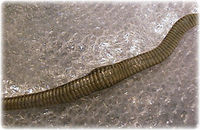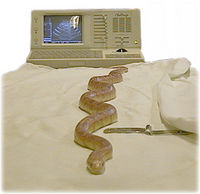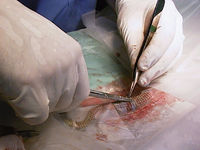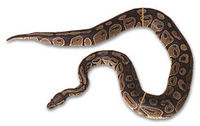Snake Lumps and Bumps
| This article has been peer reviewed but is awaiting expert review. If you would like to help with this, please see more information about expert reviewing. |
Examination
Abnormal swellings are one of the commonest presentations in snakes. Visible or palpable masses may be either the presenting complaint or they may be found during the physical examination. History will reveal that many lumps such as abscesses and neoplasia will be progressive while others will appear as if they developed overnight. Physical examination will give an indication of aetiology because of position. The differential diagnosis is in part based on the position of the lump in the body.
- For information on snake anatomy, see here.
Diagnosis
The majority of lumps are abscesses, but not all are! Radiology may define the aetiology because of the radiographic appearance. Additionally, haematology and biochemistry, fine needle aspiration, contrast radiography, ultrasonography, endoscopy, biopsy and faecal examination may be used. Culture and sensitivity are especially important.
Find out more about snake:
Therapy
Treatment is very varied and dependent on the aetiology but frequently involves surgery to investigate and remove the masses. Treatment of abscesses (one of the most common dermatological problems) involves surgical removal and systemic antibiotics based upon a culture and sensitivity.
- For more information on snake surgery, see here.
Prevention
A preventive medicine program, including quarantine, holds the key to a healthy reptile collection. Good husbandry practices produce animals that are not stressed and conditions not conducive to disease. Hygienic conditions decrease contamination of abscess-forming bacteria. Prophylactic treatments decrease parasite numbers before they become a problem (see snake mites). Veterinary involvement allows treatment to be instigated at an early stage.
Differential diagnosis of lumps
The differential diagnosis will depend on the position of the lump in the body so knowledge of the position of organs is important. For more information on snake anatomy, see here. Abscesses may occur anywhere in the body and must be included in any differential diagnosis. Neoplasia is similar. Some causes:
- In the cranial third of the snake - ingested foreign bodies, cardiomyopathies or pericardial effusions, visceral gout and goitre (see snake respiratory system and cardiovascular system).
- In the middle third - ingested foreign bodies, intestinal intussusception, visceral gout, cholecystomegaly due to bile duct obstruction or coccidiosis, ripe or atretic follicles, inflammation of any organs including gastritis caused by Cryptosporidium and Monocercomonas, colitis due to Entamoeba, omphalitis and steatitis (see snake digestive system.
- In the caudal third - ingested foreign bodies, intestinal intussusception, uric acid colonoliths, renal and visceral gout. Impacted or abscessed anal glands, or hemipenes in a male snake may cause masses at the base of the tail. See renal disease, excretion and dystocia.



